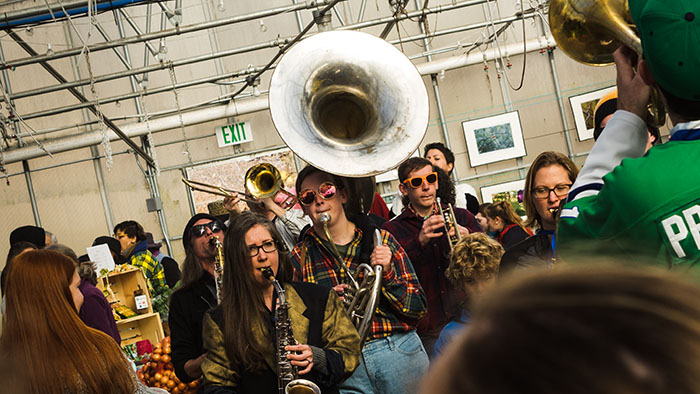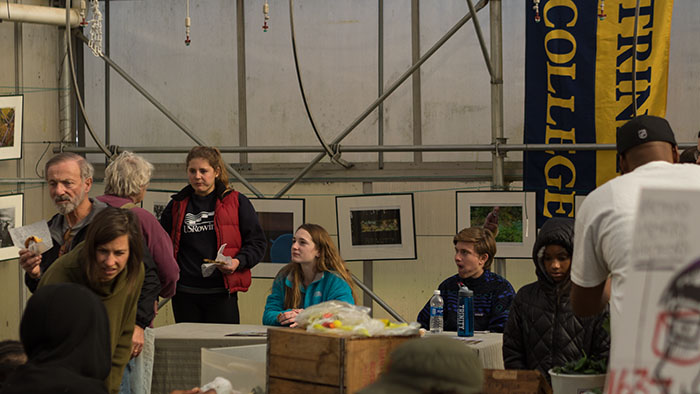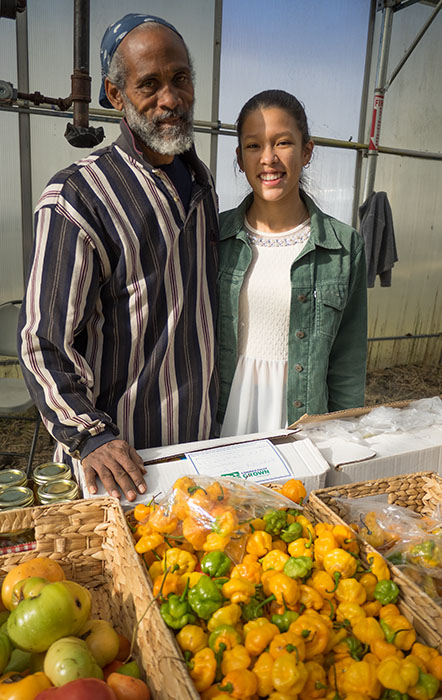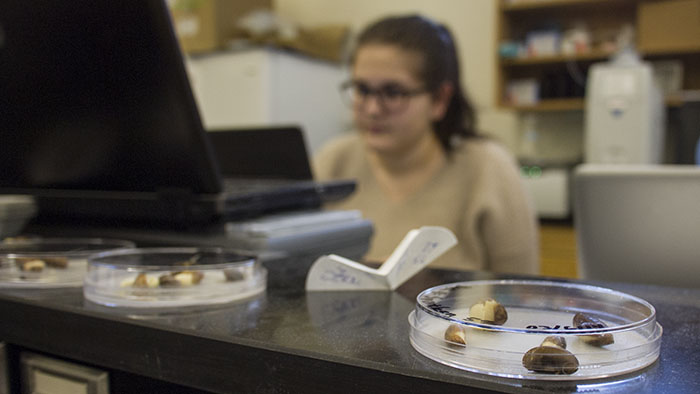Cassia made a cool video about this year’s Iceland trip. You can check it out here:
Category Archives: courses
Dr. Cass and Science Max earn extra credit for ENVS 204
As part of this year’s ENVS 204 lab Jon offered extra credit to students who would make a science video describing some experiments about air pressure and atmospheric circulation. Here is Cassia and Max’s entry. Have fun!
Christoph’s First-Year Seminar Exhibits Photographs at KNOX Parks’ Harvest Market
 This Saturday Christoph’s first-year seminar presented the fruits of its semester-long photography project at the annual Knox Parks Foundation harvest Market. The students had been learning about the role of nature photography in conservation efforts and complemented their classroom work by visiting several community gardens in Hartford and taking pictures.
This Saturday Christoph’s first-year seminar presented the fruits of its semester-long photography project at the annual Knox Parks Foundation harvest Market. The students had been learning about the role of nature photography in conservation efforts and complemented their classroom work by visiting several community gardens in Hartford and taking pictures. KNOX Parks was nice enough to give us a large corner of their greenhouse to display our images and to set up a little information table where we told visitors about the project Alley and Noelle did an amazing job distributing our catalogs, and everybody had a good time, enjoying the music of several bands, sampling local food (it was Cecilia’s first exposure to Mac and Cheese) and meeting up with some of their photography subjects.
KNOX Parks was nice enough to give us a large corner of their greenhouse to display our images and to set up a little information table where we told visitors about the project Alley and Noelle did an amazing job distributing our catalogs, and everybody had a good time, enjoying the music of several bands, sampling local food (it was Cecilia’s first exposure to Mac and Cheese) and meeting up with some of their photography subjects.
 Christoph was also busy recruiting potential speakers for next year’s 149 class. So, all-in-all it was a great success.
Christoph was also busy recruiting potential speakers for next year’s 149 class. So, all-in-all it was a great success. Here are a few examples of our artwork:
Here are a few examples of our artwork:
Signs of Spring
Our measly winter has been coming to an early end this year. Even before the first spring flowers appeared, Christoph took his soils class out of the classroom and into the field. Digging was a bit limited a few weeks ago when he and his students visited Zion Cemetery, where soils are characterized by a thin deposit of eolian sediment. Here we described our first soil profile, measured infiltration rates and tried not to look too suspicious.
This week we went to Wethersfield Cove, where we studied floodplains and floodplain soils. The river was still high, but none of us got too muddy, and we had a good view of the partially flooded floodplain and immature floodplain soils. Next week we’ll be digging up the hydric soils of Wintergreen Woods and, maybe, the Wilkus Farm.
Oysters behind McCook
The topic of Jon’s senior seminar sounds pretty grim: For several weeks now, our senior have learned about “our dying oceans”. A few weeks ago, on a beautiful, sunny March afternoon, Ryan Birch (’98) who is working as assistant conservation office in Brewster, MA paid us a visit and taught us all about oysters, how to grow them, how to harvest them, and – most importantly – how to shuck and eat them. :-)
Needless to say, there were no leftovers. Thank you Ryan!
ENVS 275 Students conquer the Park River yet again!
by Dr. Joan Morrison
Even last night’s serious rainstorm did not deter Sarah and Helen from braving the raging torrents in the North Branch of the Park River to get the flow and depth data needed to calculate stream discharge, part of their Methods project. At least it was an exciting day, quite different from the past few weeks where the stream has hardly even been a quarter meter in depth and flow rates close to 0 cf/s.
9 students – 90 minutes – 150 lbs of multiflora rose and garlic mustard …
Burnham Brook in Pouring Rain
Nope, the weather wasn’t at its finest when our senior seminar class left for Burnham Brok in East Haddam, CT. It was actually raining pretty hard and it didn’t stop until we arrived about an hour later to meet Steve Gephart from the CT DEEP. Steve and Mike Fotos gave us a guided tour of Burnham Brook Preserve, one of the first properties in Connecticut donated to the Nature Conservancy by Dick Goodwin, a Connecticut College professor who helped to establish the Nature Conservancy in the early 1960’s.
The Burnham Brook Preserve consists of 1022 acres of forested land and includes two small streams. It was amazing to see these two streams, even after prolonged heavy rain, run completely clear and still within their banks – the result of a nearly completely protected watershed area.
We spent about two hours hiking through the preserve, listening to Steve and Mike’s stories about the preserve and their explanation of various ecological features. We were all pretty wet after our trip, but not too cold to visit the local ice cream shop, where we sampled a large variety of locally made flavors. All-in-all: a very successful trip!
Multiflora – Here we come!
 This week students in Biological Invasions (ENVS 220L) began to map invasive species in a nearby natural area adjacent to Cemetery Brook and Hartford’s Hooker Environmental Science magnet school. Students will spend several weeks mapping and quantifying invasive plants that are present at the site, and then develop a management plan that will ultimately be passed on to the school, a local non-profit and the city of Hartford who hope to restore the site. Stay tuned for updates on the progress of this exciting project, and to find out if Jenna, Sarah and Cristina ever made it out of the dreaded multiflora rose-ringed swamp of no return!
This week students in Biological Invasions (ENVS 220L) began to map invasive species in a nearby natural area adjacent to Cemetery Brook and Hartford’s Hooker Environmental Science magnet school. Students will spend several weeks mapping and quantifying invasive plants that are present at the site, and then develop a management plan that will ultimately be passed on to the school, a local non-profit and the city of Hartford who hope to restore the site. Stay tuned for updates on the progress of this exciting project, and to find out if Jenna, Sarah and Cristina ever made it out of the dreaded multiflora rose-ringed swamp of no return!
ENVS 149 Spills the Beans
Jon saved one of the most fun labs of the semester for the week before spring break. Over the past week our students have grown beans and tried to poison them with various compounds. Some samples clearly didn’t look so good any more.

So, what did we learn this week?
1. Sparkleen soap is not very good at killing beans. methanol does much better.
2. Error bars are a pain in the – you know what – to produce in Excel.



























